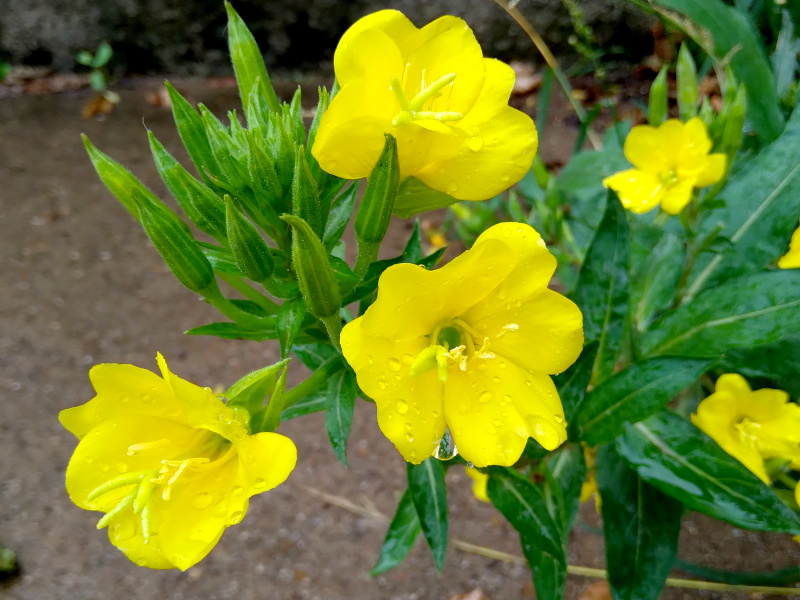Wise Mind Herbs
Evidence-based Herbal Healing
The information on this page has been prepared with reference to published scientific literature, not by a medically qualified expert. It is not medical advice. Any decision to use a supplement or herb-based product is your responsibility. Consult a suitably qualified medical professional, especially if you have underlying conditions. Remember, nothing is for everyone, and not everything sold is what it claims to be. Some things work for some people, some of the time.
Evening Primrose - Oenothera biennis
Evening primrose (Oenothera biennis) is a flowering plant native to North America that produces oil-rich seeds. It should not be confused with other plants sometimes called primrose, including common primrose (Primula vulgaris) or Chinese primrose (Primula sinensis), which are entirely different species with different properties. Evening primrose oil (EPO) has been extensively studied for its therapeutic potential due to its high content of gamma-linolenic acid (GLA), an omega-6 fatty acid.

Image source and license: https://commons.wikimedia.org/wiki/File:Oenothera_biennis,_2022-08-30,_South_Side_Slopes,_03.jpg.
Modified by Peter Jorgensen.
Botanical Information
Scientific name: Oenothera biennis L. (most common species used medicinally)
Common names: Evening primrose, evening star, sun drop, king's cure-all, fever plant, night willow-herb
Related species sometimes used similarly: Oenothera lamarckiana, Oenothera glazioviana
Plants sometimes confused with evening primrose: Primula vulgaris (common primrose), Primula sinensis (Chinese primrose), which belong to an entirely different plant family and do not contain the same therapeutic compounds.
Active Constituents
The main therapeutic component in evening primrose oil is gamma-linolenic acid (GLA), typically comprising 8-10% of the oil. Other constituents include linoleic acid (65-80%), oleic acid (6-11%), palmitic acid (5-12%), and stearic acid (1-5%). Standardized extracts typically contain 8-10% GLA.
Evidence-Based Health Benefits
- Atopic Dermatitis: Moderate evidence suggests EPO can improve symptoms in some patients, particularly those with specific delta-6-desaturase enzyme deficiencies. Studies have found modest improvements in itching and overall severity.
- Premenstrual Syndrome (PMS): Mixed evidence exists for symptom improvement, particularly breast pain (mastalgia). EPO may reduce breast tenderness and mood symptoms compared to placebo.
- Rheumatoid Arthritis: Limited evidence suggests modest anti-inflammatory effects; the clinical significance of plant-based omega supplements is low.
- Diabetic Neuropathy: Mixed evidence for improvement in nerve function and symptoms, with more positive results in earlier studies than recent research.
- Menopausal Symptoms: Limited evidence for reduction of hot flashes and night sweats, with inconsistent results across studies.
Conditions NOT Proven to Be Treated by Evening Primrose
- Cancer: Despite some preliminary laboratory research, no clinical evidence supports EPO as a cancer treatment.
- Cardiovascular disease: Insufficient evidence for blood pressure reduction or cholesterol improvement.
- Multiple sclerosis: Early promising results have not been confirmed in larger trials.
- ADHD: Limited studies with inconsistent results.
- Alzheimer's disease: Insufficient clinical evidence.
Recommended Dosages
- Atopic Dermatitis: 2-4g of EPO daily (providing approximately 160-320mg GLA)
- PMS: 3-6g of EPO daily (providing approximately 240-480mg GLA)
- Rheumatoid Arthritis: 2.8g EPO daily (providing approximately 225mg GLA)
- Diabetic Neuropathy: 4-6g of EPO daily (providing approximately 320-480mg GLA)
- Standardization: Most commercial preparations are standardized to contain 8-10% GLA
- Duration: Most studies have administered EPO for 8-12 weeks to observe clinical effects
Side Effects and Safety Concerns
- Generally well-tolerated with primarily mild side effects
- Common side effects: Gastrointestinal disturbances (nausea, soft stools, flatulence)
- Headache and infrequent allergic reactions have been reported
- Theoretical increased bleeding risk when combined with anticoagulants
- Potential seizure threshold lowering in patients with epilepsy, particularly when taking phenothiazines
- Pregnancy safety: Insufficient evidence, not recommended during pregnancy
High-Dose Studies and Knowledge Gaps
Studies investigating doses above 6g daily are limited. Doses up to 8g daily for severe PMS symptoms have shown no significant additional benefit compared to a standard 4-6g dose, while more gastrointestinal side effects are reported. No formal maximum tolerated dose studies have been published in the past decade. This represents a significant knowledge gap regarding potential therapeutic windows and dose-response relationships.
Studies investigating long-term use (>6 months) are notably lacking, creating uncertainty about sustained efficacy and safety with extended use. Additionally, the variability in GLA content across commercial products creates challenges in standardizing research findings.
Pharmaceutical Products
- Epogam® - Standardized evening primrose oil capsules marketed for atopic dermatitis in some European countries
- Efamast® - Evening primrose oil formulation previously marketed for mastalgia
Note: In the United States, evening primrose oil is regulated as a dietary supplement, not a pharmaceutical. The products listed above are primarily available in European and Asian markets. No FDA-approved pharmaceutical products containing evening primrose oil exist in the US market.
References
El-Sayed, R. M., Moustafa, Y. M., & El-Azab, M. F. (2014). Evening primrose oil and celecoxib inhibited pathological angiogenesis, inflammation, and oxidative stress in adjuvant-induced arthritis: novel role of angiopoietin-1. Inflammopharmacology, 22, 305-317.
Farag, M. A., Reda, A., Nabil, M., Elimam, D. M., & Zayed, A. (2023). Evening primrose oil: a comprehensive review of its bioactives, extraction, analysis, oil quality, therapeutic merits, and safety. Food & function, 14(18), 8049-8070.
Jaafarnejad, F., Adibmoghaddam, E., Emami, S. A., & Saki, A. (2017). Compare the effect of flaxseed, evening primrose oil and Vitamin E on duration of periodic breast pain. Journal of education and health promotion, 6(1), 85.
Jamilian, M., & Afshar, R. (2017). Effects of combined evening primrose oil and vitamin D intake on hs-CRP, oxidative stress and pregnancy outcomes in women with gestational diabetes. J Arak Univ Med Sci, 19(12), 43-51.
Senapati, S., Banerjee, S., & Gangopadhyay, D. N. (2008). Evening primrose oil is effective in atopic dermatitis: a randomized placebo-controlled trial. Indian journal of dermatology, venereology and leprology, 74, 447.
Sultana, A., Heyat, M. B. B., Rahman, K., Kunnavil, R., Fazmiya, M. J. A., Akhtar, F., ... & De La Torre Díez, I. (2022). A systematic review and meta-analysis of premenstrual syndrome with special emphasis on herbal medicine and nutritional supplements. Pharmaceuticals, 15(11), 1371.